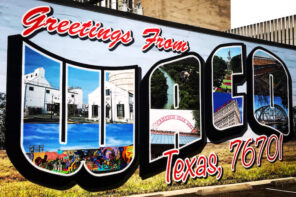At the Salt Lake City premiere of Under the Banner of Heaven, writer, director, and producer, Dustin Lance Black explained that the series sought to tell a broader story of Mormonism, including Mormon experiences foreign to most viewers. By this time, some critics and media comments responded to Banner by arguing it incorrectly portrayed Mormonism (broadly defined) as a violent and dangerous faith. Few considered Black’s goal and the reality that Banner didn’t only seek to portray the Church of Jesus Christ of Latter-day Saints, the largest religion under the “Mormon” umbrella.
Under the Banner of Heaven is the true-crime bestseller about Ron and Dan Lafferty, two brothers who made headlines after a double murder shook a suburban Utah town. The men were raised in the Church of Jesus Christ of Latter-day Saints, a religion that most are familiar with to some degree. However, in the 1970s, the men joined a small group of believers who understood themselves to be the most authentic remnant of the religion founded by Joseph Smith in 1830.
As the show opened, some people began to see a reflection of their own experience in the series—many for the first time. In a public Facebook post, a historical consultant for the show, Troy Williams of Equality Utah, spoke of his experience investigating the fundamentalist Apostolic United Brethren after his LDS mission. One woman on Twitter explained, “It’s been a weird ride realizing that the version of Mormonism taught in my home probably qualifies as fundamentalist.” She continued, “Honestly the biggest thing Banner evoked in me was the feeling that I wasn’t crazy and that my experience was finally seen.”
Banner is one of many stories that can be told about Mormon fundamentalism, a religious tradition most often associated with the continued practice of polygamy. It’s also indicative of the growing reality that the term “Mormon” is increasingly separate from a single institutional identity. Mormonism encapsulates the over 400 religions that trace themselves to Joseph Smith, as well as the individual families whose beliefs and practices differ from “traditional” experiences with the faith. This includes the Lafferty brothers.
As Hulu subscribers anticipate the release of the seven-episode series, some have wondered about these smaller Mormon religions and questioned the prevalence of Mormon fundamentalism in the contemporary United States. The history of Mormon fundamentalism offers important context for Banner and illuminates the reality that, while small in numbers, Mormon fundamentalism is relatively common.
But, what is a Mormon fundamentalist?
It was almost 50 years after the death of the religion’s founder that the LDS Church began the long process of ending the practice of polygamy. In 1890, under pressure from the United States government that sought to seize Church assets and disincorporate the religion, the Church released a document referred to as the “Manifesto” that announced the formal end to the practice.
At least, this is the most often told history of Mormon polygamy. However, for those who still believe in the practice, there’s another history of equal importance. On September 27, 1886, the President of the LDS Church, John Taylor, was in hiding for his controversial marriages. According to the men who were present that evening, Taylor was met by both the resurrected Jesus Christ and Joseph Smith and received a revelation, referred to as the 1886 Revelation. The document proclaimed that all laws of God were irrevocable. For members of the Mormon fundamentalist movement, this meant one thing: against all odds, polygamy is here to stay.
In later accounts, one of the men present during the revelation claimed that John Taylor ordained six men who were tasked with ensuring polygamy’s survival. The legacy of these men came to be known as the Council of Friends and included Lorin C. Woolley, Joseph W. Musser, John Y. Barlow, J. Leslie Broadbendt, and Charles Zitting. With these ordinations, Mormon fundamentalism was born.
Today, most Mormon fundamentalists trace their history to one of these men. Notable examples include the Apostolic United Brethren who most people know from their prominent place on Sister Wives, and the FLDS, the religion that became infamous during the 2008 raid at the Yearning for Zion Ranch. Together, these groups once comprised the majority of Mormon fundamentalists in the nation which, at the height of the movement, included an estimated 40,000 adherents.
In addition to the AUB and FLDS, people might be familiar with other groups from headlines and documentaries, including the Kingston group, LeBaron group, and Centennial park, to name a few. While these are the prominent examples, the last twenty years saw a rise in “independent” Mormon fundamentalism, polygamous or non-polygamous families who seek to live the “fundamentals” of the faith without official membership in a Church. Independent fundamentalism made headlines in 2019 with the tragic murder of families from LaMora, Mexico.
But Mormon fundamentalism doesn’t just include the groups with histories connected to Woolley or the 1886 Revelation. And it isn’t just about polygamy. Today, fundamentalist Mormonism encapsulates the experience of many men—and it is men—who claim divine revelation as the impetus to start their own group. This includes Robert Crossfield, the Lafferty’s leader after the brothers became disenfranchised by the LDS Church.
Crossfield (a.k.a. Prophet Onias) was a convert to the LDS Church who in 1961 began receiving revelations that were later published as the Second Book of Commandments and Book of Onias. His revelations and publications led to his excommunication and the formation of his own Mormon religion that attracted many in the Salem, UT area who believed the LDS Church had gone astray.
This is the complicated Mormonism represented in Under the Banner of Heaven. While some might watch the show and question the extent to which the families in Banner are indicative of a common trajectory, the show mirrors a trend that began when the group of men in 1886 wondered if the Church could be wrong about an end to polygamy.
Banner depicts the Mormonism of many young women who convert to fundamentalism and enter sealings as a third wife; fathers who teach their children the Adam-God Doctrine; and mothers who encourage their neighbors to join consecration efforts—all of which were, but are no longer, a part of the Church of Jesus Christ of Latter-day Saints. The sentiment also mirrors the reality that after the end to the priesthood and temple restrictions that barred Black Latter-day Saints from access to the temple in 1978, LDS families joined the Apostolic United Brethren because they worried their Church fell into apostasy.
The series reflects the increasing reality that “Mormonism” isn’t monolithic and that the Mormon experience is vast; at times existing apart from an easily defined institution. It also reflects the reality that sometimes Mormonism can lend doctrinal support to men who commit horrific crimes, like Bryan David Mitchell, Arvin Shreeve, Warren Jeffs, Ervil LeBaron, and the Lafferty brothers—but certainly not always, especially given that each either left the LDS Church or was excommunicated for their beliefs.
While many individuals will rightfully not see their religious experience on the screen, Banner gives voice to an under discussed experience. Banner depicts a more complicated definition of “Mormonism” and allows people whose experiences are not considered normative a time to see themselves in the story, even for the first time.





